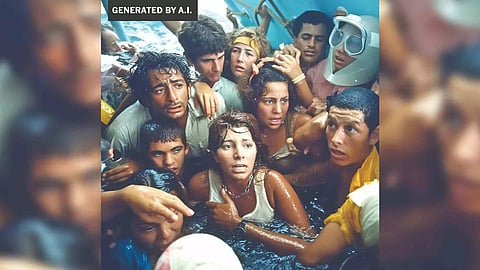

GIDEON JACOBS
John Szarkowski, the legendary former curator of the Museum of Modern Art, once described photography as “the act of pointing.” And for the nearly 200 years since its inception, photography has consisted of capturing a visual perspective from the physical world using light — first with light-sensitive plates, then film, then digital sensors. When digital cameras became widely available, many photographers lamented the move away from analog technology, but basically Szarkowski’s definition still held: Photography consists of pointing, as a reaction to something that exists in the world.
With advent of AI image generators, however, this definition feels obsolete.
Generative AI tools can produce photorealistic images, typically in response to written prompts. These images are available for purchase from major stock photography agencies alongside traditional photos. They routinely go viral before being debunked. They even occasionally win prestigious photography prizes. All of which has reignited a two-century-old debate: What exactly qualifies as a photograph?
This is not a matter of etymological nitpicking. Calling AI images “photographs” — a practice I encounter often — can add to a sense of disorientation in what already feels like a profoundly disorienting moment. Thanks to the ubiquity of digital cameras, we live in a world that’s already flooded with photographs; more than a trillion are taken each year. These digital images can already be easily manipulated through existing tools, including ones built into your phone. Yet they still have some direct relationship to real scenes and events that have occurred.
Now we face a new deluge of images that, however artful or convincing, are at a remove from the world. AI images are typically digital composites of countless existing photographs, so by what definition are they themselves real? No wonder some observers are asking: How can we believe anything we see?
Aside from very real concerns about the livelihoods of professional photographers, especially those who work in commercial photography, I worry that A.I. image generators may leave society as a whole more vulnerable to widespread manipulation — as presaged by hoax A.I. images of Donald Trump violently resisting arrest or, somewhat more comically, of Pope Francis wearing a Balenciaga-inspired coat.
Artists, writers and theorists have long remarked on our very human tendency to project slippery ideas about truth onto two dimensional surfaces. In Susan Sontag’s 1977 essay “In Plato’s Cave,” she wrote, “Although there is a sense in which the camera does indeed capture reality, not just interpret it, photographs are as much an interpretation of the world as paintings and drawings are.” Each photograph, she argued, is inevitably the product of countless decisions informed, consciously or not, by the photographer’s predilections and biases, as well as the limits and parameters of the technology.
So when I hear some people calling the arrival of AI an extinction-level event for photography, I often think of the French painter Paul Delaroche who, legend has it, declared painting “dead” after seeing a daguerreotype, one of the first photographic inventions. Painting did not die; it just evolved into a different kind of artistry, freed from the obligations of verisimilitude.